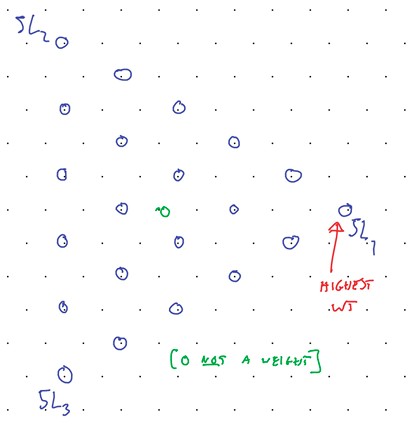4.20. Lecture 20
4.20.1. Irreducible representations of .
We are now in a position to state the main theorem of -theory.
Theorem 4.20.1.
For every pair of non-negative integers, there is a unique (up to isomorphism) irreducible finite-dimensional representation of with a highest weight vector of weight .
Note that the highest weights occurring in the theorem are exactly the dominant elements of the weight lattice.
Since every irreducible finite-dimensional representation does have a highest weight, necessarily dominant, every irreducible representation is isomorphic to for some integers .
Example 4.20.2.
We have already seen some examples:
-
(i)
The standard representation is irreducible with highest weight , therefore
-
(ii)
The dual to the standard representation is irreducible with highest weight , and so
-
(iii)
The adjoint representation is irreducible with highest weight , and so
-
(iv)
The symmetric square has highest weight with highest weight vector .
4.20.2. Proof of theorem 4.20.1
Lemma 4.20.3.
Let be a finite-dimensional representation of . Let be a highest weight vector of weight , and let
Then
-
(i)
is a subrepresentation of
-
(ii)
i.e. is the unique weight vector in of weight , up to scaling.
-
(iii)
is irreducible.
Proof.
-
(i)
Let
Then
Firstly, it is clear that and take to , and so preserve . Since
we see that also preserves .
Secondly, every is a weight vector (by the fundamental weight calculation, Lemma 4.19.1) and so an eigenvector for all , . Thus preserves each (and hence also ).
Finally, we show that preserves . A similar proof then applies for , and then preserves by the same argument as for . We prove the statement for by induction on .
For , . Since is a highest weight vector, and so .
Suppose that the claim is true for . Consider with . We must show that . Suppose first that . Then, as , we have
by the induction hypothesis and the fact that is preserved by as required. The proof in the case is similar, using that .
-
(ii)
Note that if the weight of , with and as in the lemma, then a calculation using the fundamental weight calculation, as in the proof of lemma 4.19.7, shows that
and so if . Since these vectors span , is the unique (up to scalar) weight vector in of weight .
-
(iii)
Suppose that is reducible. By complete reducibility (Theorem 3.14.7) we have
for non-zero proper subrepresentations of . We must have for unique , . The unicity implies that and are both weight vectors of weight so, by part (ii), either or . Without loss of generality let . But then all as is a subrepresentation, so contradicting that is a proper subrepresentation.
∎
Remark 4.20.4.
It follows that as in Lemma 4.20.3 is actually the subrepresentation generated by , that is, the span of all vectors obtained by applying arbitrary elements of some number of times. The content of the lemma is then that it suffices to apply only and .
Proof of Theorem 4.20.1.
First we show the existence. Let . Consider
This has a highest weight vector of weight . Let be the representation generated by . Then is irreducible by 4.20.3(iii), and has a highest weight vector of weight . Thus we can take .
Next we show the uniqueness. Suppose that are two irreducible representations with highest weight vectors and , respectively, of weight . Let be the representation generated by . Then is irreducible by 4.20.3(iii). The projection sending to restricts to a homomorphism which sends to . This is therefore a non-zero homomorphism between irreducible representations, and so must be an isomorphism. Thus . Similarly , and so as required. ∎
In fact, it is possible to give an explicit description of the irreducible representations.
Theorem 4.20.5.
Let and . Define
to be the map
Then is a surjective -homomorphism, and its kernel is the irreducible representation with highest weight .
Proof.
This is Problem 4.7. ∎
4.20.3. Exercises
Problem 57. Show that, if is a finite-dimensional representation of with a unique highest weight vector (up to scalar multiplication), then is necessarily irreducible.
Deduce that the standard representation, its dual, and the adjoint representation are irreducible.
Problem 58.
-
(a)
Find the weights of and draw the weight diagram.
-
(b)
Show that
is a highest weight vector with weight .
-
(c)
Let . Calculate and and show that they are linearly independent.
-
(d)
Show that
and find the weight diagram for .
Problem 59. (harder!)

The aim of this problem is to show that, for ,
It suffices to show that is irreducible with highest weight .
-
(a)
Show that has a basis of weight vectors
and that these have distinct weights (so, every weight has multiplicity one).
-
(b)
Show that is the unique highest weight vector in , up to scalar multiplication.
-
(c)
Deduce that is an irreducible representation with highest weight . See problem 4.20.3.
Problem 60. (monster!) Let , let , and let . For , define .
Let
be defined by
where means is omitted (and similarly for ).
-
(a)
Show that is an -homomorphism.
-
(b)
Show that has a unique highest weight vector of weight for each , and no other highest weight vectors.
-
(c)
Show that the highest weight vector from the previous part is in if and only if .
-
(d)
Deduce that is the irreducible representation of highest weight .
-
(e)
Show that is surjective, and hence decompose into irreducibles.
-
(f)
Find the dimension of . Find its weights.
This problem is hard! For a solution, see Fulton and Harris, section 13.2, but watch out for the unjustified ’clearly’ just before Claim 13.4.